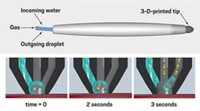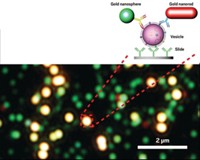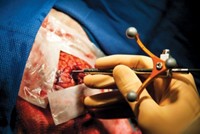Advertisement
Grab your lab coat. Let's get started
Welcome!
Welcome!
Create an account below to get 6 C&EN articles per month, receive newsletters and more - all free.
It seems this is your first time logging in online. Please enter the following information to continue.
As an ACS member you automatically get access to this site. All we need is few more details to create your reading experience.
Not you? Sign in with a different account.
Not you? Sign in with a different account.
ERROR 1
ERROR 1
ERROR 2
ERROR 2
ERROR 2
ERROR 2
ERROR 2
Password and Confirm password must match.
If you have an ACS member number, please enter it here so we can link this account to your membership. (optional)
ERROR 2
ACS values your privacy. By submitting your information, you are gaining access to C&EN and subscribing to our weekly newsletter. We use the information you provide to make your reading experience better, and we will never sell your data to third party members.
Diagnostics
Nanoprobes spot brain cancer from a blood draw
By combining machine learning with surface-enhanced Raman spectroscopy, researchers can distinguish between types of cancer and locate brain tumors
by Prachi Patel, special to C&EN
October 18, 2022

Cancer tumors shed DNA, proteins, other molecules, and cells into the bloodstream long before they can be spotted with techniques like magnetic resonance imaging. A new liquid biopsy technique could help diagnose brain cancer earlier by detecting those molecules in a tiny blood sample (ACS Nano 2022, DOI: 10.1021/acsnano.2c04187).
The technique relies on an ultrasensitive nanosensor that can amplify the Raman vibrational signal of cancer biomarkers present in blood at extremely low concentrations. Researchers used the method to distinguish brain tumors from other types of cancer and determine a tumor’s general location within the brain.
“Blood tests are a lot easier and less expensive than imaging,” says Bo Tan, an engineer at Toronto Metropolitan University who led the new study. And unlike conventional brain tissue biopsies, they would not require a surgical procedure to get a sample. But liquid-based cancer tests developed until now rely on amplifying small amounts of cancer-linked DNA in blood, and that doesn’t work very well for diagnosing brain cancer because of the blood-brain barrier—the blockade of cells that keeps most DNA and other cancer biomarkers from crossing between the brain and the bloodstream.
To detect these biomarkers in blood samples, Tan and her colleagues wanted to do a holistic analysis of multiple molecules in blood. They turned to surface-enhanced Raman spectroscopy (SERS), a technique in which nanostructured metal surfaces boost molecules’ natural Raman signals.
They first made the nanosensor by bombarding a nickel substrate with a high-intensity laser beam, creating nickel–nickel oxide nanoparticles on the surface. The team then collected samples from 60 people—20 each with glioblastoma brain tumors, lung cancer, and breast cancer—and placed their blood serum on the nanosensor. Each sample generated a Raman spectrum specific to the mixture of biomolecules present, and those spectra could be decoded by a machine learning algorithm that the researchers created to identify various cancer types.
When they tested the system with spectra from a different set of serum samples from people with cancer, it could differentiate between brain, lung, and breast cancer with 100% sensitivity and specificity. The algorithm could determine the location of brain tumors in each of nine regions of the brain with about 96% accuracy. “They all have their own specific Raman signature, so this could be used as a diagnostic tool, which is exciting,” says study coauthor Sunit Das, a neurosurgeon and clinical scientist at St. Michael’s Hospital and the University of Toronto.
All of this can be done with less than 10 µL of blood sample, Tan says. “So the good thing is that you can run this test in parallel with regular blood work.” The team is now further validating and testing the sensor and the machine learning algorithm in a larger cohort of patient samples, she says.
The researchers should test the liquid biopsy method on less aggressive forms of brain cancer and in larger cohorts, comments Catherine Alix-Panabières, a cancer cell biologist and liquid biopsy expert at the University of Montpellier. Nevertheless, while preliminary and not yet validated externally, she finds the new technique’s ability to detect brain cancer markers in such small blood samples very promising.





Join the conversation
Contact the reporter
Submit a Letter to the Editor for publication
Engage with us on Twitter